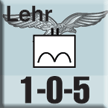| Gazala 1942:
Desert Parachutes
by Mike Bennighof, Ph.D.
May 2017
The war in the desert lasted almost three
years, from June 1940 until May 1943. During
those years a number of German and Italian
airborne units fought in Libya and Egypt,
from the independent battalions of Italian
paratroopers who bravely resisted the initial
British offensive into Libya to the Folgore
Division and Ramcke Brigade that held the
center of the Axis line at El Alamein when the
Afrika Korps collapsed.
Only once, it appears, did the Germans or Italians seriously
contemplate dropping airborne troops to influence a battle.
One German battalion had arrived in Libya in May 1942, the
Burkhardt Battalion of “Lehr” or demonstration
troops that would eventually become part of the Ramcke Brigade
and fight at Alamein.

The battalion had veteran leadership and an experienced cadre,
and was somewhat overstrength for a German parachute battalion
(1,200 men). Like all such formations, it was lightly armed
and especially lacking in anti-tank weapons.
Rommel had the battalion available for
the Operation Venezia, the offensive that
would become known as the Battle of Gazala
and is featured in our game
of desert combat. The German staff did not employ the
paratroopers at all in the offensive, even in a ground role,
keeping them in the strategic reserve. But the air transport
appears to have been available for a battalion-sized drop.
Therefore, we’ve provided a free download of this
unusual battalion, available
here.
The Axis player may attempt an airborne landing with the
Lehr battalion. During the Initial Segment, the Axis player
secretly notes that the Lehr battalion will land two turns
later, and the hex in which it will land. The hex specified
must be a clear hex, and may not be adjacent to a minefield
or fortification hexside. Otherwise, the Lehr battalion may
land anywhere on the map.
|
Safe
Landing? |
| |
1-3 |
Eliminated |
| |
4-6 |
Lands safely |
|
On
Target? |
| |
1-2 |
Drifts
one hex |
| |
3-6 |
Lands on target |
|
Drift:
Where? |
| |
1
|
Northeast |
| |
2
|
East |
| |
3
|
Southeast |
| |
4
|
Southwest |
| |
5 |
West |
| |
6 |
Northwest |
| |
|
|
Two turns later the Axis player announces the landing attempt
during any Axis impulse and rolls one die. On a result of
1 through 3 the unit is eliminated (disrupted by Allied fighters,
or so badly scattered as to be rendered ineffective).
On a
result of 4 through 6 the unit is placed in the noted hex
and a second die is rolled to determine if the landing occurred
where planned. On a result of 3 through 6 the unit remains
in place, on a result of 1 or 2 it drifts. Roll yet another
die to determine the drift. On a result of 1 the unit is shifted
one hex to the northeast, on a result of 2 one hex to the
east, on a result of 3 one hex to the southeast, on a result
of 4 one hex to the southwest, on a result of 5 one hex to
the west, and on a result of 6 one hex to the northwest.
If the unit lands in a prohibited hex (hill, sea or one adjacent
to a minefield or fortification) it is eliminated. If the
hex is enemy-occupied, the Lehr unit must initiate combat
against the enemy unit(s) in the upcoming Combat Phase; if
the hex is not cleared of enemy units, the Lehr battalion
is eliminated. Other Axis units may participate in this combat
if they are adjacent to the hex.
The Lehr unit is activated on the turn it lands by activation
of the Afrika Korps headquarters (it can be reassigned later,
but MUST be activated by Afrika Korps). The unit is considered
to be in supply during the turn it lands.
Click
here to order Gazala
1942 now!
Mike Bennighof is president of Avalanche Press and holds a doctorate in history from Emory University. A Fulbright Scholar and award-winning journalist, he has published over 100 books, games and articles on historical subjects.
He lives in Birmingham, Alabama with his wife, three children and his dog, Leopold.
|
